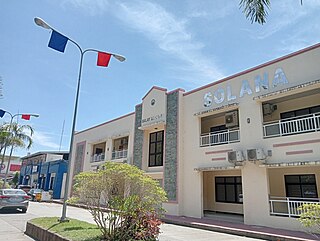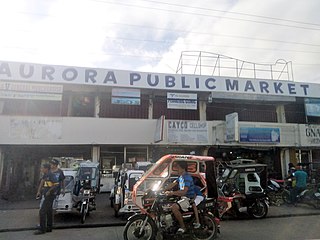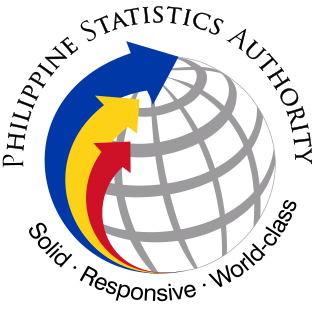Related Research Articles

Famy, officially the Municipality of Famy, is a 5th class municipality in the province of Laguna, Philippines. According to the 2020 census, it has a population of 16,791 people, making it the least populated municipality in the province.

Kalayaan, officially the Municipality of Kalayaan, is a 3rd class municipality in the province of Laguna, Philippines. According to the 2020 census, it has a population of 24,755 people.

Santol, officially the Municipality of Santol, is a 4th class municipality in the province of La Union, Philippines. According to the 2020 census, it has a population of 14,166 people.

Solana, officially the Municipality of Solana, is a 1st class municipality in the province of Cagayan, Philippines. According to the 2020 census, it has a population of 88,445 people.

Aurora, officially the Municipality of Aurora, is a 2nd class municipality in the province of Isabela, Philippines. According to the 2020 census, it has a population of 36,621 people.

Burgos, officially the Municipality of Burgos, is a 4th class municipality in the province of Isabela, Philippines. According to the 2020 census, it has a population of 26,040 people.

Kabacan officially the Municipality of Kabacan, is a 1st class municipality in the province of Cotabato, Philippines. According to the 2020 census, it has a population of 77,164 people.

Dipaculao, officially the Municipality of Dipaculao, is a 3rd class municipality in the province of Aurora, Philippines. According to the 2020 census, it has a population of 33,131 people.

Calaca, officially the City of Calaca, is a component city in the province of Batangas, Philippines. According to the 2020 census, it has a population of 87,361 people.

Buguias, officially the Municipality of Buguias,, is a 3rd class municipality in the province of Benguet, Philippines. According to the 2020 census, it has a population of 44,877 people. The municipality is home to the mummy of Apo Anno, one of the most revered and important folk hero in Benguet prior to Spanish arrival.

Kapangan, officially the Municipality of Kapangan,, is a 4th class municipality in the province of Benguet, Philippines. According to the 2020 census, it has a population of 19,297 people.

Mankayan, officially the Municipality of Mankayan, is a 1st class municipality in the province of Benguet, Philippines. According to the 2020 census, it has a population of 37,233 people.

The Philippine Statistics Authority is the central statistical authority of the Philippine government that collects, compiles, analyzes, and publishes statistical information on economic, social, demographic, political affairs, and general affairs of the people of the Philippines, as well as enforcing the civil registration functions in the country.
The Philippines is divided into four levels of administrative divisions, with the lower three being defined in the Local Government Code of 1991 as local government units (LGUs). They are, from the highest to the lowest:
- Regions are mostly used to organize national services. Of the 17 regions, only one—the Bangsamoro Autonomous Region in Muslim Mindanao—has an elected government to which the central government has devolved competencies.
- Provinces, independent cities, and one independent municipality (Pateros)
- Component cities and municipalities within a province
- Barangays within a city or municipality

The Technical Education and Skills Development Authority serves as the Philippines' Technical Vocational Education and Training (TVET) authority. As a government agency, TESDA is tasked to both manage and supervise the Philippines' Technical Education and Skills Development Authority(TESDA). Its goals are to develop the Filipino workforce with "world-class competence and positive work values" and to provide quality technical-educational and skills development through its direction, policies, and programs.

A purok is an informal division within a barangay in the Philippines. While not officially considered a local government unit (LGU), a purok often serves as a unit for delivering services and administration within a barangay.

The Philippine census is a regularly occurring and official inventory of the human population and housing units in the Philippines. Since 1970, the population has been enumerated every five years. Results from the censuses are used to allocate congressional seats and fund government programs.

Speed limits in the Philippines are specified in Republic Act No. 4136, or the Land Transportation and Traffic Code of the Philippines, which took effect on its approval on June 20, 1964. The act covers a number of areas other areas than speed limits, and was amended regarding some of those areas by Republic Act No. 10930, which was approved on August 2, 2017.
The following are the events in related to Philippine law in 2016. This includes developments in criminal investigations of national notability.
The PHIVOLCS earthquake intensity scale is a seismic scale used and developed by the Philippine Institute of Volcanology and Seismology (PHIVOLCS) to measure the intensity of earthquakes.
References
- ↑ "Statistical Classification Systems". psa.gov.ph. Philippine Statistics Authority | Republic of the Philippines. Retrieved 11 September 2024.
 This article incorporates text from this source, which is in the public domain .
This article incorporates text from this source, which is in the public domain . - 1 2 3 4 "Philippine Standard Geographic Code (PSGC)". Philippine Statistics Authority | Republic of the Philippines.
 This article incorporates text from this source, which is in the public domain .
This article incorporates text from this source, which is in the public domain .